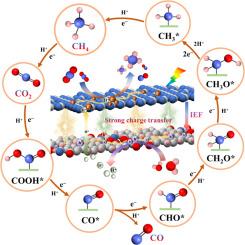具有π-π堆叠的全有机S-scheme氮化碳/苝酰亚胺异质结调节CO2光还原PCET过程
IF 14.3
1区 材料科学
Q1 MATERIALS SCIENCE, MULTIDISCIPLINARY
引用次数: 0
摘要
利用光催化技术高效地将CO2转化为碳氢燃料是一个关键问题。然而,光生载流子的热力学势不足和多质子耦合电子转移(PCET)过程缓慢严重阻碍了CH4和其他碳氢化合物的形成。因此,我们构建了一个具有π-π相互作用的大π离域的全有机s型异质结光催化剂(CN/UPDI-x), CO和CH4产率分别为34.10和4.55 μmol g−1 h−1,其中CH4产率分别是原始CN和UPDI的12.3和11.7倍。s方案异质结提高了光生电子-空穴对的分离效率,保留了加速水氧化生成H*所需的高氧化空穴,并使大量高能电子的积累能够驱动反应中间体的转化。此外,CN和UPDI形成的广泛π-电子离域体系为光生电子的快速输运提供了有效途径。高效供给的H*与CO2在异质结界面吸附在CN上形成中间的*CHO。该中间体通过多步氢化过程进一步转化为CH4。本研究为设计和开发适用于环境保护和清洁能源生产的有机聚合物半导体光催化剂提供了新的视角。本文章由计算机程序翻译,如有差异,请以英文原文为准。

All-organic S-scheme carbon nitride/perylene imide heterojunction with π-π stacking modulates the PCET process for CO2 photoreduction
It is a critical proposition to efficiently convert CO2 into hydrocarbon fuel utilizing photocatalytic technology. However, the insufficient thermodynamic potential of photogenerated carriers and the sluggish multi-proton coupled electron transfer (PCET) process severely hinder the formation of CH4 and other hydrocarbons. Hence, we constructed an all-organic S-scheme heterojunction photocatalyst (CN/UPDI-x) with large π-delocalization via π-π interactions, with CO and CH4 yields of 34.10 and 4.55 μmol g−1 h−1, where the CH4 yields were 12.3 and 11.7 times higher than those of pristine CN and UPDI, respectively. The S-scheme heterojunction improves the separation efficiency of photogenerated electron-hole pairs, preserves the highly oxidizing holes required for accelerating water oxidation for H* production, and enables a substantial accumulation of high-energy electrons that drive the conversion of reaction intermediates. Moreover, the extensive π-electron delocalization system formed by CN and UPDI offers an efficient pathway for the rapid transport of photogenerated electrons. The high-efficiency supply of H* coupled with CO2 adsorbed on the CN at the heterojunction interface to form intermediate *CHO. This intermediate is further transformed into CH4 through a multi-step hydrogenation process. This work provides novel perspectives for the design and development of organic polymer semiconductor photocatalysts applicable to environmental protection and clean energy production.
求助全文
通过发布文献求助,成功后即可免费获取论文全文。
去求助
来源期刊

Journal of Materials Science & Technology
工程技术-材料科学:综合
CiteScore
20.00
自引率
11.00%
发文量
995
审稿时长
13 days
期刊介绍:
Journal of Materials Science & Technology strives to promote global collaboration in the field of materials science and technology. It primarily publishes original research papers, invited review articles, letters, research notes, and summaries of scientific achievements. The journal covers a wide range of materials science and technology topics, including metallic materials, inorganic nonmetallic materials, and composite materials.
 求助内容:
求助内容: 应助结果提醒方式:
应助结果提醒方式:


